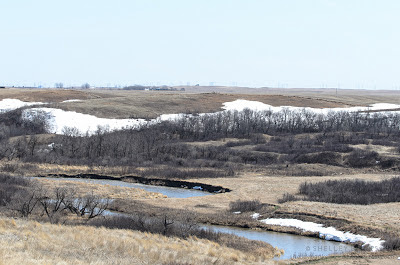 |
| Listening for summer, the Prairie Crocus waits. © SB |
I saw my
first Prairie Crocuses of this year this morning — I'm so happy to have found so many budding, blooming, fading on a hillside near Regina, Saskatchewan.
There was still snow in the crevices of the valley below where the Prairie Crocuses crept out from under dry grasses.
But the slopes at Wascana Trails were dry, with a warm wind and not a tick in sight. (Wood tick, that is. The curse of seeking early spring native plants.)
I love these furry stemmed wild flowers. The petals darken as they age, from deep purple through violet to white.
And many of the blossoms were tipped over, which brings me to a wonderful note from
Royer/Dickinson's lovely book, Plants of Alberta:
The Prairie Crocus is called the "ears of the earth" because it seems to spring through the snow to listen for the approach of summer. Legend also tells of the Great Spirit giving this delicate plant a fur coat to keep it warm through cold spring nights.
On to more flower pictures...
First, a view of the coulee where these flowers grew, from the north side looking into the sheltered (and still snowy) southern banks. Next, a shot of many flowers, peeping out from old dry grasses. Finally, more close-ups of flowers.
For
more pictures of Prairie Crocuses, see my photography blog, at
http://shelleybanksphotos.blogspot.ca/. (I posted two there that I
really like...)
 |
| View into the Valley, below the slope where the Prairie Crocus grow. © SB |
 |
| Dozens of Prairie Crocus plants in full flower streamed down the hillside. © SB |
 |
| Close-up of a group of Prairie Crocuses © SB |
 |
| One single Prairie Crocus flower. © SB |
 |
| A Prairie Crocus pair, listening... © SB |
Prairie Wildflower: Prairie Crocus. (aka Pasque-flower, Pulsatilla patens, or Anemone patens.)
Location: Slopes of Wascana Trails, near Regina, Saskatchewan, Canada.
Photo Date: May 9, 2013.






















